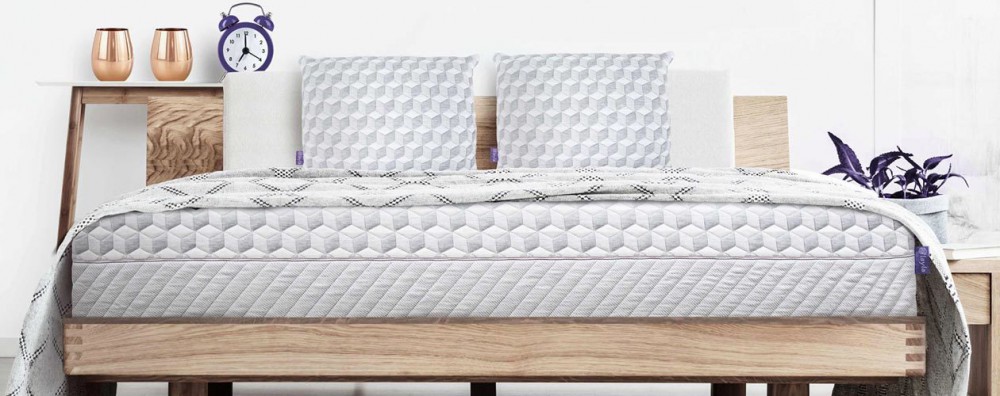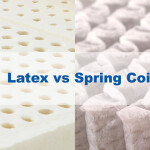Memory Foam vs. Pillow Top Mattresses: Which Provides The Ultimate in Comfort?
Mattresses are having a big moment right now. Check your social media feeds, watch a YouTube video, or sit back to view a TV show, and you are likely to get a dose of mattress advertising. These aren’t the boring mattress ads of yesteryear, today’s sleep marketing is filled with edgy humor, and lots of claims about getting the best night sleep ever.
data-ad-client="ca-pub-1542090382626399"
data-ad-slot="7742579998">
Most of these new and seemingly ever-present ads are for bed-in-a-box products, typically featuring memory foam construction. You’ve likely heard a few of the brands: DreamCloud, Puffy, Nectar, Casper, Leesa, and countless more.
By some estimates, there are now over 100 different bed-in-a-box companies. These are the mattresses that show up on your doorstep in an oblong box. You drag the shrink-wrapped bundle to your box spring or bed frame, pop the plastic and let the mattress unfurl and puff up to life.
With all these new options on the market, one might wonder if there is a place for traditional mattresses, such as a traditional innerspring model with a pillow top. Once, these mattresses were the epitome of comfort. You might not be able to get one shipped to you in a shrink-wrapped container, but most areas have plenty of mattress shopping options.
We decided to put memory foam mattresses against traditional innerspring mattresses, and chose pillow tops as they are built for comfort. But, before we dive into the merits of each of these mattress options, let’s talk a bit about sleep and the state of the mattress industry today.
The Importance of Sleep
Everyone has heard that most adults require eight hours of sleep every night. While this may or may not be true depending on your age, lifestyle and personal needs, we can all agree that sleep is an important component of a healthy life. Sleep helps reset your body and mind.
When we are well-rested, our health improves, we are less likely to have weight issues, and even our exercise routines are supported. In fact, if you work out regularly, you probably notice an increased need for sleep. That’s your body talking — your muscles need the ability to reset while your sleep.
As many people know, getting a good night’s sleep requires more than just deciding to lay down for eight hours. Life is hectic, and its influence is hard to shut off at will. Many people suffer from varying levels of insomnia, from a mild difficulty in falling asleep to full-blown extended sleeplessness. While a mattress isn’t always the miracle cure to sleep problems, comfort is a key component to help people switch off the stresses of their day.
Different Mattress Solutions
It’s also important to note that sleep preferences are highly individual in nature. Some like a firm mattress, others want to sink into a cloud. Memory foam offers a cocoon-like experience that is simultaneously soft and supportive, but some people feel that the mattresses are too hot. Those who like the cooling and comfortable experience of a traditional mattress may dislike how it develops dead spots over time.
To these various comfort preferences, people sleep in different ways. Some drop into deep sleep on their backs, and doctors advocate back sleeping as the best option for all people except those with snoring issues. Others are side sleepers — the second-best choice of sleep doctors. Sleeping on one’s stomach is often considered the worst position, as your spine is put in an unnatural position of overarching. And then there are those who shuffle among these choices until they eventually fall asleep.
For all the different types of sleepers, there are as many mattress options. In addition to traditional innerspring construction, there’s memory foam, gel memory foam, latex and hybrid mattresses. In each category of materials there are additional choices, such as the amount of support or cushion, and whether the materials are synthetic or natural.
Although memory foam and latex are the two trendiest types of mattresses on the market today, only memory foam currently poses a threat to traditional innerspring mattresses. Of the 100-plus bed-in-a-box brands, memory foam makes up the majority, and is often much less expensive than latex. So, we decided to focus on memory foam versus pillow top innerspring.
Memory Foam Details
Memory foam mattresses use several layers of foam to provide support and comfort. A balance between these two features is crucial, since overly firm foam feels like a gym mat and foam that is too cushy can feel like sleeping in quicksand. Remember, sleeping comfort is important, but you need to be able to get in and out of the bed with ease as well.
Material
The basic material used in memory foam is like a sponge. Foam is in all sort of furniture, such as couches, chair cushions and even innerspring mattresses, but memory foam acts much differently. When compressed, the foam conforms to the pressure. When you get out of bed, the foam springs back to a zero-state.
Memory foam has its origins in the United States space program. In the 1970s, NASA was looking to improve seat cushioning and to provide better crash protection. Initially called “temper foam,” this material quickly moved from space applications to home use and use in helmets and shoes.
Although the specific components differ from manufacturer to manufacturer, most memory foam is polyurethane. Typically, there is a top layer, which might contain perforations for cooling, then there are layers of comfort foam and higher-density materials for support. Layers can contain different gels, too, depending on the brand and level of support.
Hybrid memory foam mattresses typically combine memory foam with latex and innersprings. This mashup usually results in a soft and conforming top with traditional mattress support.
Comfort
Since memory foam relieves painful pressure points, it can improve sleep for many people. The experience of sleeping on memory foam is often likened to floating. Your body heat warms the foam slightly, and the only part of the foam that moves is that which your body touches. For a lot of people, this suspended feeling is quite comfortable.
In addition to relieving pressure points, memory foam also supports back and spine alignment. On a memory foam mattress, your body weight gets spread out evenly across the surface of the foam, which keeps your back in a neutral position. Contrast this with a traditional innerspring mattress, where body weight is concentrated at the points where springs make contact to the mattress top layer.
Brands
As we stated in the introduction, there are countless brands of memory foam beds. Some are market leaders, some are economy brands, and others target specific needs.
The top brands of memory foam beds include:
- Puffy
- Muse
- DreamCloud
- Casper
- Layla
- Loom & Leaf
- Nectar
- Plushbeds
In addition, many discount retailers carry their own branded memory foam products. This includes Ikea and Big Lots stores.
Memory foam prices
Memory foam mattresses are available in almost any price point, from $200 to $2,000 and beyond. The most expensive brand is not necessarily the best for you. A $2,000 mattress may have additional bells and whistles that provide little benefit to your sleep. On the other hand, you get what you pay for, and a bargain-brand memory foam mattress is likely going to be much thinner and lacking in supportive material.
Buying a memory foam mattress is easy. The new guard of mattress companies feature customer-friendly ways to get their product into bedrooms. A decade ago, no one would have considered ordering mattresses online, unless it was from a company that provided so-called white-glove delivery. While many of bed-in-a-box companies provide this service, which includes removal of your old mattress and setup of the new one, there is often an added fee.
If you are happy to handle the mattress setup yourself — and the process is simple — the memory foam bed will show up on your doorstep just a few days after ordering. The manufacturers recommend getting a partner to help with the setup, as the mattresses can be a bit heavy.
The tricky bit is your old mattress. If you don’t pay for white glove service, or if it’s not available from the brand you choose, you will be stuck getting rid of your old mattress. For many, this is the main reason to prefer taking a trip to a mattress store, where delivery of the new mattress and removal of the old has been standard practice for many years.
Buy online, or in person
Luckily, most mattress stores also sell a lot of memory foam brands. Some of the most popular memory foam mattresses, such as Purple, are available at Mattress Firm.
Often, people like to shop for a mattress in person since they can try it out on the showroom floor. Online mattress companies know this and compete by offering a money-back trial period. Some brands offer 90 days, some let your sleep on their mattress for 100 nights, while others such as Nectar, gives you a full year with a money-back guarantee.
Pillow Top Mattresses
A pillow top mattress is a much different product than memory foam. They do not feel the same, the materials work differently, and the buying process is more traditional. But for all the hype and convenience of new mattresses, many find the combination of innerspring support and plush top comfort is the perfect solution to great sleep.
These are also quite popular, reigning as the top of the line mattress products for many years prior to the introduction of mass memory foam options. A pillow top mattress is the same mattress you grew up sleeping on, with a thick layer of comfort on top. These luxurious mattresses are top of the line and provide unparalleled comfort performance, especially during the first few years of ownership. Let’s look a little closer into the benefits of the pillow top sleeping experience.
Material
As an innerspring mattress, pillow tops are constructed out of fabric, foam or textile cushioning such as fiberfill, spring coils, and other materials aimed at holding the mattress in shape. The pillow top can be made out of different types of cushioning material, much like a pillow. Common pillow top materials include fiberfill and foam.
Comfort
A pillow top mattress is exceptionally comfortable. Although it doesn’t provide the weightless sensation of a memory foam mattress, the mattress itself is often quite firm with comfort concentrated in the pillow top. It feels like sleeping on a pile of pillows. The plushness is usually subdued a bit, since swimming in a sea of pillows might not be that comfortable. It may be more accurate, then, to liken the experience to sleeping on some thin or medium pillows.
The resulting comfort is balanced, but there is a bit of a trade-off. Over time, innerspring mattress coils compress and start to become less responsive. Eventually, the mattress will develop spots where your body sinks into the mattress. These dead spots can either become a source of comfort or, more often, back pain.
Pillow Top Mattress Brands
Shoppers looking for traditional comfort can shop for these brands:
- Serta Perfect Sleeper
- Sealy Response Essentials
- Sleep Inc.
- Simmons
- Beauty Rest
- Stearns and Foster
In addition, mattress, furniture and some department stores have store brand product lines that often include pillow top options.
Prices and Availability
While pricing for memory foam mattresses general gravitates around a certain range, traditional innerspring mattresses vary widely. This is likely due to how the mattress market has thrived for years prior to recent bed-in-a-box disruption. In the past, price directly correlated with quality. The more you spent, the better sleep you’d get. So, one can buy a queen size pillow top mattress for as little as $400 to over $4,000.
Traditional innerspring mattresses are more difficult to transport and setup, since they require multiple hands and maneuvering up flights of stairs. Because of this, people typically order from an outlet that provides free setup and removal of your old mattress.
Comparing Memory Foam and Pillow Top Mattresses
Now that we’ve taken a close look at the various features of these two mattress types, how do they stack up against each other? Although mattress preference is highly subjective, there are some basic characteristics that are helpful to know before choosing where you rest your head.
Comfort
Each of these mattress types are designed for comfort, so this is one area of comparison that boils down to personal preference.
The comfort provided by memory foam is engulfing. You feel as if you are partially sunken into the mattress. This is a great feature for those who are easily disturbed when their sleeping partner moves, because the isolating comfort of memory foam also inhibits motion transfer. So, just like in the TV commercial from years ago, you can bounce a bowling ball on one side of the mattress while you balance a glass of red wine on the other side.
On the other hand, some people feel trapped when sleeping on memory foam. Others feel like they are crawling in quicksand if they veer too close to the middle of the bed at night and have to get to the edge.
Pillow top mattresses provide a different type of comfort. This classic plushness is soft but not engulfing. The underlying innerspring coils provide bounce and responsiveness, in addition to support. The main gripes with pillow top mattresses is that they can be too soft, which may lead to back pain and pressure points.
Temperature
A more objective test of comfort is heat retention. Memory foam can get notoriously hot — body heat is necessary for its function. An innerspring mattress with a pillow top has no such issues. Memory foam companies have incorporated new technologies to mitigate heat transfer, such as cooling gel layers.
Durability and edge support
Another area of concern for mattress owners is durability. Memory foam is resilient. Its NASA pedigree means that it stands up to years of abuse. Innerspring mattresses are prone to sagging and wear. But while memory foam is longer lasting than traditional innerspring mattresses, they often have an unusual feeling to them when you sit on the edge of the bed – as if you are going to fall into the center.
This lack of edge support may be an important consideration if you often sit on the edge of the bed for reading or watching television or other activities.
Mattress odor
A final concern about both mattresses is their odor when brand new. A brand new innerspring mattress will smell like any other new piece of furniture. Since less chemicals are used in construction, there is less off-gassing, which is a frequent complaint of memory foam and latex beds. Memory foam odor goes away with time, but if you are sensitive to chemical smells, you might want to opt for a different material.
Our Verdict: Where You Should Rest Your Weary Bones
For our money, the best choice is a combination of these two mattress construction styles. A hybrid mattress, such as the DreamCloud bed gives you the best of both worlds, while minimizing some of their negative qualities.
data-ad-client="ca-pub-1542090382626399"
data-ad-slot="7155901418"
data-ad-format="auto">

Source: Internet





